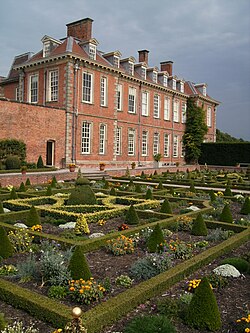Hanbury Hall
| Hanbury Hall | |
|
National Trust | |
|---|---|
 Hanbury Hall and parterre | |
| Grid reference: | SO943637 |
| Information | |
| Website: | Hanbury Hall |
Hanbury Hall in Worcestershire was built by the wealthy chancery lawyer Thomas Vernon in the early 18th century. Thomas Vernon was the great grandson of the first Vernon to come to Hanbury, Worcestershire, Rev Richard Vernon (1549–1628). Rev Richard and his descendants slowly accumulated land in Hanbury, including the manor, bought by Edward Vernon in 1630, but it was Thomas through his successful legal practice who added most to estates, which amounted to nearly 8,000 acres in his successor Bowater Vernon’s day.
Hanbury Hall is thought to stand on the site of the previous mansion, Spernall Hall, and Thomas Vernon first describes himself as ‘of Hanbury Hall’ in 1706, and this and other evidence leads to a likely completion date of about 1706. The date of 1701 above the front door is thought to be a Victorian embellishment, but no building accounts are known to exist.
Although Hanbury Hall appears to be of a very uniform style, the rear wall is clearly of a different and rather earlier style, and may mark the first phase of a building campaign when Thomas Vernon and his wife Mary first came into possession of Spernall Hall in 1692 when his bachelor uncle John Vernon died.
A notable feature of Hanbury Hall is the painting of the staircase, hall ceiling, and other rooms by the English painter Sir James Thornhill. They include a small representation of Rev Henry Sacheverell being cast to the furies – this relates to an incident in 1710 when Sacheverell, a Tory, was put on trial for sedition by the Whig government, and dates the paintings to that year. The focus of the paintings around the stairwell is the life of the Greek hero Achilles, as told by a range of classical sources. They are surmounted by a large representation of the Olympian gods on the ceiling.
The original plan of the Hall had a large undivided central hall with the main staircase leading off it, with many rather small rooms in the corner pavilions and north range – the south range was given over mainly to service rooms. The 18th century Worcestershire historian Treadway Nash, in his Collections for the History of Worcestershire, wrote “Here is a large handsome house built by Counsellor Vernon about the year 1710 when a bad style of architecture prevailed; many windows and doors, rooms small, many closets, few arched cellars, large stables and offices in full view, are marks of that time”.
When the heiress Emma Vernon (1754–1818) married Henry Cecil, 1st Marquess of Exeter in 1776, Cecil clearly was of the same opinion, as he remodelled the interior (other than the great hall) creating larger rooms and enlarging the north east pavilion. On the south façade, having removed a doorway he repositioned all the windows to lie under their first floor equivalent. On the south side there had been large formal gardens, clearly shown in Dougharty’s perspective drawing contained in the estate maps of the 1730s, and Cecil swept all these away (including the farm buildings in front of the Hall) and landscaped the park in the fashion of the time – he would have had contact with Capability Brown when being brought up by his uncle 9th Earl of Exeter at Burghley House.
Following Henry and Emma’s divorce in 1791 the contents were all sold, and the house remained empty until Henry’s death in 1804, when Emma and her third husband, John Phillips, were able to regain possession. As the house had lain unoccupied for so long, many repairs had to be carried out at that time. Emma died in 1818 and left her second cousin, Thomas Shrawley Vernon (1759-1825), as the heir to her estate after the death of her husband John Phillips. Phillips married again and had two daughters in Hanbury before finally moving out in 1829. From then, the eldest son of Emma's heir, Thomas Tayler Vernon (1792–1835), was able to occupy it. His grandson Harry Foley Vernon (1834–1920) MP, was created 1st Baronet of Hanbury in 1885, and was succeeded by his son Sir (Bowater) George Hamilton Vernon (1865–1940), 2nd Baronet. Sir George led an unhappy life, separating from his wife Doris, and spending his last 10 years living with his secretary and companion Ruth Horton, who later changed her name by deed poll to Vernon. During this time the agricultural depression led to a reduction in rental income, and Hanbury Hall suffered a lack of care.
After Sir George Vernon's death in 1940, there were no further heirs to the Baronetcy which became extinct, though his widow remained until her death in 1962, when it was bequeathed to the National Trust.
Outside links
| ("Wikimedia Commons" has material about Hanbury Hall) |
- Hanbury Hall - National Trust
References
- Vernon archives in the Worcestershire Record Office BA 7995







